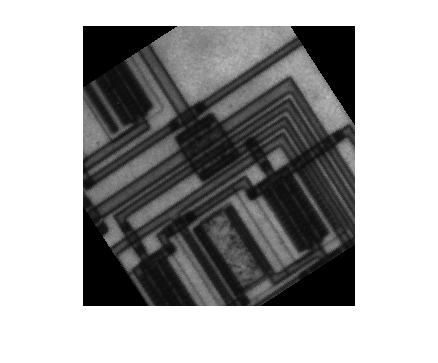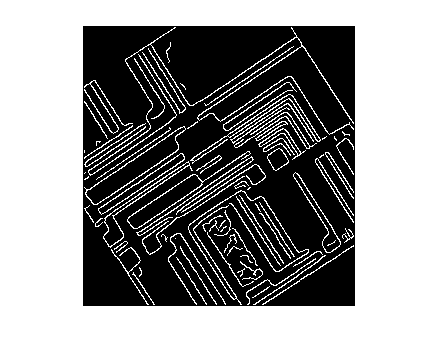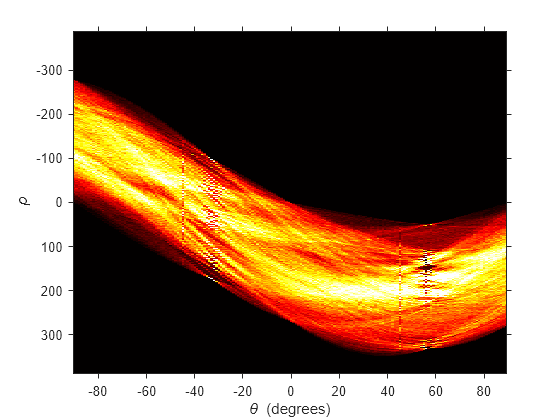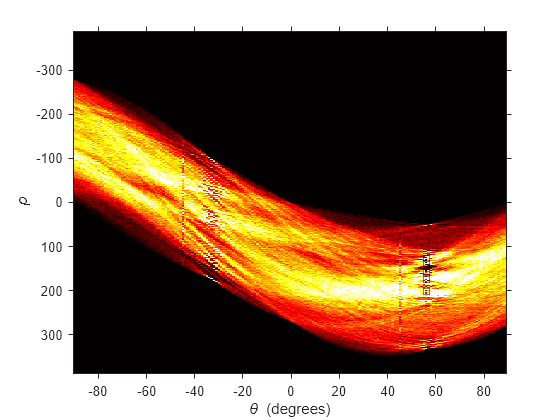霍夫变换
Image Processing Toolbox™ 支持使您能够使用霍夫变换检测图像中线条的函数。
hough 函数实现标准霍夫变换 (SHT)。霍夫变换设计为使用线条的参数化表示来检测线条:
rho = x*cos(theta) + y*sin(theta)
变量 rho 是沿垂直于线条的向量从原点到线条的距离。theta 是 x 轴与此向量之间的角度。hough 函数生成一个参数空间矩阵,其行和列分别对应于这些 rho 和 theta 值。
在计算霍夫变换后,您可以使用 houghpeaks 函数来求得参数空间中的峰值。这些峰值表示输入图像中可能存在的线条。
在标识霍夫变换中的峰值后,可以使用 houghlines 函数求得霍夫变换中对应于峰值的线段的端点。此函数自动填充线段中的小间隙。
使用霍夫变换检测图像中的线条
此示例说明如何使用 Hough 变换检测图像中的线条。
将一个图像读入工作区中,为了使此示例更具说明性,请旋转该图像。显示图像。
I = imread('circuit.tif'); rotI = imrotate(I,33,'crop'); imshow(rotI)

使用 edge 函数找到图像中的边缘。
BW = edge(rotI,'canny');
imshow(BW);
计算由 edge 返回的二值图像的霍夫变换。
[H,theta,rho] = hough(BW);
显示由 hough 函数返回的变换 H。
figure imshow(imadjust(rescale(H)),[],... 'XData',theta,... 'YData',rho,... 'InitialMagnification','fit'); xlabel('\theta (degrees)') ylabel('\rho') axis on axis normal hold on colormap(gca,hot)

使用 houghpeaks 函数,在霍夫变换矩阵 H 中找到峰值。
P = houghpeaks(H,5,'threshold',ceil(0.3*max(H(:))));在标识了峰值的变换图像上叠加一个绘图。
x = theta(P(:,2)); y = rho(P(:,1)); plot(x,y,'s','color','black');

使用 houghlines 函数查找图像中的线条。
lines = houghlines(BW,theta,rho,P,'FillGap',5,'MinLength',7);
创建一个显示原始图像并在其上叠加线条的绘图。
figure, imshow(rotI), hold on max_len = 0; for k = 1:length(lines) xy = [lines(k).point1; lines(k).point2]; plot(xy(:,1),xy(:,2),'LineWidth',2,'Color','green'); % Plot beginnings and ends of lines plot(xy(1,1),xy(1,2),'x','LineWidth',2,'Color','yellow'); plot(xy(2,1),xy(2,2),'x','LineWidth',2,'Color','red'); % Determine the endpoints of the longest line segment len = norm(lines(k).point1 - lines(k).point2); if ( len > max_len) max_len = len; xy_long = xy; end end % highlight the longest line segment plot(xy_long(:,1),xy_long(:,2),'LineWidth',2,'Color','red');
